
Keeping Up Appearances: A Story of Blended Styles
(written by Anita Taylor Doering and Sarah Ludington of the La Crosse Public Library Archives Staff with substantial contributions from Dr. Les Crocker, UWL Emeritus Professor of Art History)
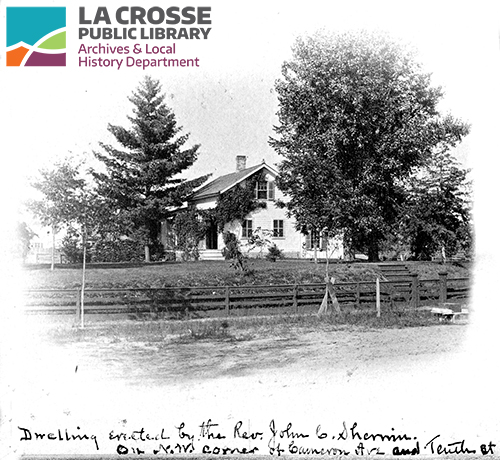
Photo by Elmer & Tenney, circa 1881, from a stereoview
This is the photo that started the conversation. At first glance, it doesn’t look like much. It’s a fairly modest, middle-class home without much style, but was typical for the “frontier” time period when Yankees came west to Wisconsin to colonize the territory, overcoming natural and other obstacles, including clearing the land of Indigenous populations for white settlement.
Reflecting upon this image for the first time, Dr. Les Crocker, retired architectural historian, noted that it was “a somewhat peculiar house, the gable end seems almost twice as wide as the ‘front’ on the left. There is a single-story addition on the far right that seems to be board-and-batten construction.” As an archivist, Anita Taylor Doering wondered why a photographic image of this house was commissioned. Photography at this point was reserved for professionals and it was a time-intensive and expensive process, especially outside in the elements that the photographer could not control. It was not like snapping an image with your smart phone today. The subject of the image itself is not overly decorative and does not seem to evoke anything particularly special. There aren’t any people or animals in the photo either – simply just the house.
Dr. Crocker continued with his observations, “Another addition on the left is suggested by the segment of a lower roof just barely visible. A central chimney, which was not common in this time period. I would estimate the pine tree out front to be 15-20 years old. There is a much larger and older tree on the right. Some newly planted saplings between the road and what will be a sidewalk eventually. A stake of some sort and a pile of something to the right of the supported sapling. Perhaps preparation for street paving.”
Doering was concerned that the caption on this photo was incorrect since Dr. Crocker had just completed a blog on the oldest existing house in La Crosse. A caption written long ago in ink pen on the stereoview card said, “Dwelling erected by the Rev. John C. Sherwin on NW corner of Cameron Ave. & 10th St.” Collectively, we knew that this set of Elmer & Tenney stereoviews dated from about 1880 or 1881, but through previous research, we have found that some views from this set, especially unnumbered ones like this, could date as early as the 1870s. Doering wanted to set the caption straight once and for all, especially since Dr. C’s blog talked about Rev. Sherwin’s house at 5th and State – nowhere near this house. She contemplated which was wrong – the attribution to Rev. Sherwin or the location of the house or worse yet – both??
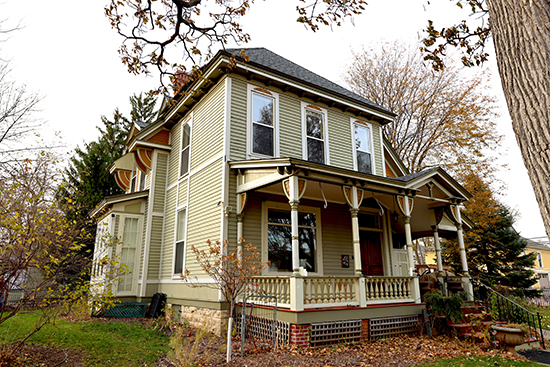
324 So. 10th Street, November 2023
Research by the LPLA began in earnest on the current house at the northwest corner of 10th and Cameron Avenue; a house we all agreed had been built in 1883/84 in the Queen Anne style for Fred Ring – nothing like the older image portrays at all. We assumed this house must have been razed to make room for the 1883 house, right? Oh, how wrong we were and the following evidence will explain why.
The house occupies three lots (7, 8, 9) of Block 1 in the Clinton and Rublee Addition to the City of La Crosse which was officially surveyed and registered in 1854, before La Crosse achieved city status. In 1861, however, land owner Rev. John C. Sherwin admits that he had not acknowledged the plat, meaning there were likely some existing improvements on properties he owned within that addition by that time.
To be specific, Sherwin built a house that faced east, when in fact those lots were platted so that the homes built would face south. Today the address is 324 10th St. South and it solemnly stands at the northwest corner of Cass and Tenth Street South, surrounded by a sturdy fence and sporting a definite Queen Anne style façade.

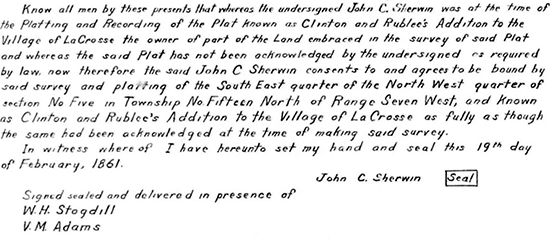
From La Crosse Series 5, Engineering Department Plats, v. 1, page 12
The best description we have of Sherwin’s life in La Crosse comes from the Charles Haas’ book "Bless the Work of Our Hands: A History of the First Congregational Church of La Crosse, Wisconsin, 1852-1972,” specifically pages 114-126.

Reverend John C. Sherwin of the First Congregational Church
Rev. John C. Sherwin was called as pastor to form the First Congregational Church in La Crosse in January 1852 and help foster and guide a fledging church comprised largely of Yankee migrants from the New England states. Sherwin had a large, growing family (15 children in the end and 13 survived infancy) and the congregation could barely scrape together any kind of a salary for a missionary preacher. To help make ends meet, Sherwin invested in land holdings. Haas traced land transactions at the La Crosse County Register of deeds office and found that Sherwin engaged in land purchases and sales as early as May 1852. During his five years in La Crosse, Sherwin made at least nine land purchases and eight land sales. This context helps to explain why and how extensive Sherwin’s land holdings were.
“I have been obliged to sell some 220 acres of land to meet the current wants of my family on this new field up to such time as my people become able to assume my entire support.” (1856)
His house was located at 5th and State streets and he was known for transplanting trees to his residence to make it seem less prairie-like and were perhaps the first trees planted in the fledging community. However, one of his land investments included the house located at 324 S. 10th Street. It was there that he built a house perhaps intended for his growing family, but it wound up becoming a rental property. Sherwin resigned his position at the First Congregational Church in October 1857 to renew his work as a missionary preacher in the frontier settlements of western Wisconsin. He remained in Wisconsin the rest of his life, dying in Eau Claire in 1892, but the people of La Crosse still held Sherwin in high esteem. Clearly, he was not only a leader of a fledging church, but also a well-regarded citizen and leader within the community. He presided over the funeral of La Crosse’s first white murder victim in 1852, and is credited with preventing vigilante violence.
Sherwin owned all of block 1 by April 1856 and there were no improvements on the lots in question in 1857. By 1858, however, there is a modest house on lot 8 and land values have increased. Sherwin begins to sell some lots in that addition by 1859 and a few more by 1861. During the Civil War, land values plummeted. Sherwin eventually sold off of his interest in block 1 by 1864, taking a loss. Sherwin no longer lived in La Crosse after 1857, so he was very much an “absentee landlord.” Land values began to rebound when Gilbert Woodward purchased lots 7-10 of Sherwin’s holdings in this addition, but again Woodward lived elsewhere in La Crosse. Rental income was not only a good way to guarantee a steady cash income, but was also a good investment for single or widowed women.

Detail from the 1859 Bliss and Spear map of the City of La Crosse showing a structure (highlighted) at the NW corner of Cameron Ave. and Cass St.
So, property tax records show that the house was a rental from the time it was built in 1858-1874 when E. G. Smith sold it to W. W. Webb who is the first owner to live in the house; he stayed from 1870-1878. Webb sold it in 1881 to Fred Ring, Jr. Ring owned the house but did not live in it until the Queen Anne addition was completed on the east side of the house, more than doubling the size of the original 1½ story house.
We also look to the municipal water hook up records for a glimpse into who has authorized this work. New construction after 1880 within the city almost always had city water lines installed during the construction process and the water turned on shortly before a new building or house was occupied for the first time. In this case, owner Fred Ring added water to an existing residence in June 1882 before he moved in, we believe this was done in preparation for modernizing or adding onto this house.
Another fortunate remnant upon which we can use, is a published list of construction during the year which included new buildings and additions to both residential and commercial buildings usually categorized by a political boundary called a ward. The January 2, 1884, Republican and Leader newspaper published building statistics and lists: Fred Ring $6,000 frame residence built during 1883.

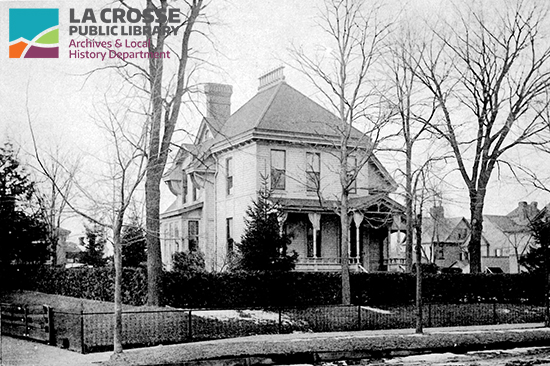
From La Crosse Illustrated, 1891
On their own, these documents don’t point to this being the same house; however, there is another tool in our property history arsenal that does The Sanborn Fire Insurance maps (which are available for La Crosse as far back as 1879) are a particularly helpful resource because they give details about dwellings and building not usually seen on most maps. In the case of this house, they provided clues about its construction. The fire map shows a wall across the house just west of the bay on the north side, with a door in the center. That line suggests to us that the older house is to the left, and if so, there should be the old foundation wall in the basement, or some newer supports in that location.
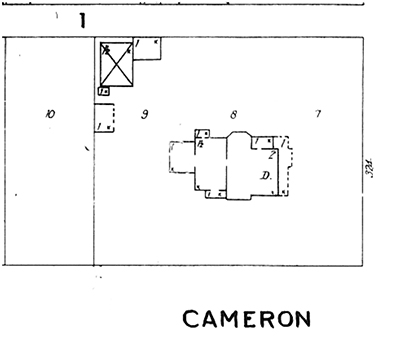
Sanborn Fire Insurance Map, 1906, sheet 33; this is the oldest Sanborn map that includes this part of town
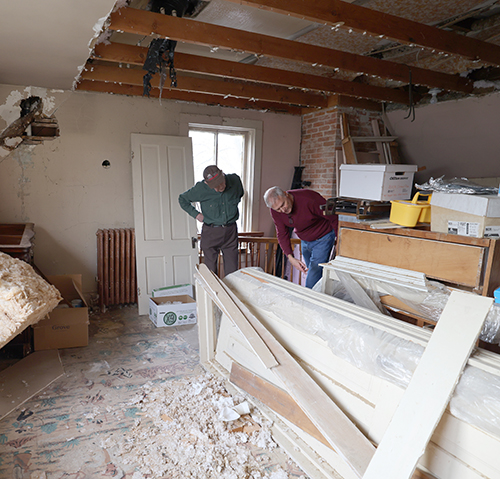
Dr. Les Crocker (left) and current home owner Mike Peterson (right) examine the second floor above the oldest part of the house.
In property history research we don't typically get access to the interior of the home itself, nor can we venture out of the Archives to do this examination, but in this case homeowner Mike Peterson was gracious to grant us access to this hidden gem of a home. Upon investigation, the house is mostly intact on the interior and exterior with the exception of the floors in the two parlors.
Normally in houses with a front parlor and family sitting room behind, especially when they are separated by a pocket door, the floor would be continuous from one room to the other so there would be no need for a covering of the joint, there wouldn’t be a joint and the pocket doors would work as intended. The two rooms could be combined for large gatherings. The two spaces would be visually linked by the floor that ran between them in the longer direction.
At some point the floor in one of the rooms was damaged enough to require replacement. It was the sitting room that has wider boards laid east to west. At a later date, late 1940s or 1950s, the parlor floor was re-laid north to south with narrow boards.
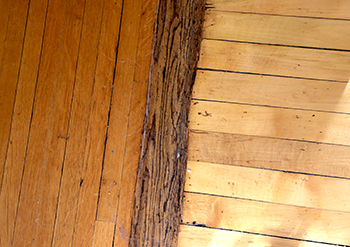
Sitting room floor on left (n-s) with narrower oak boards; current office (older house) on the right (e-w) with wider boards
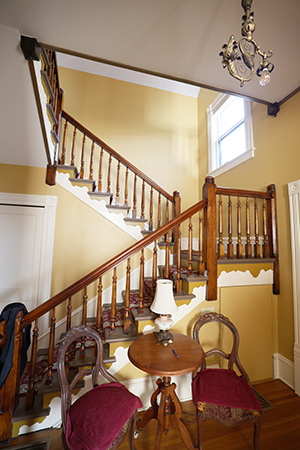
Light fixture in entry way
“The light fixture in the entrance hall is WONDERFUL! I’ve never seen anything quite like it,” – Dr. Crocker remarks on the hall’s combination gas and electric light fixture.
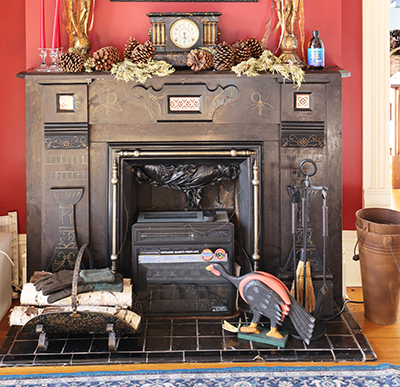
Slate or stone fireplace mantle
“The slate/stone fireplace mantles are also high points and certainly rank higher on the ‘good taste’ scale of the 1880s than commonplace marble mantles that had been available since the 1850s.”
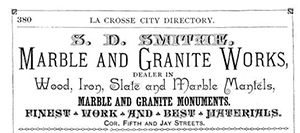
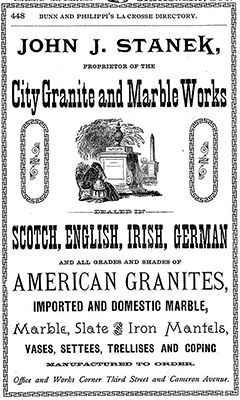
Ads from the La Crosse city directories of 1885 and 1888
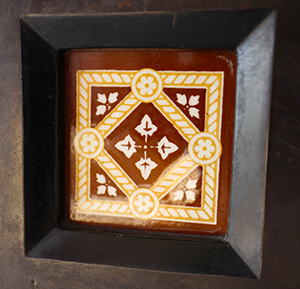
Detail of tile inset into the fireplace surround
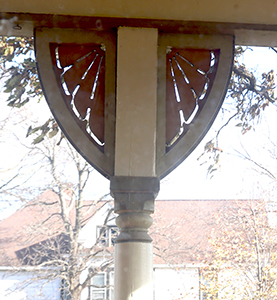
Porch column detail
"One of the outstanding and unusual features of the house decoration are the porch posts. They may be one-of-a-kind and if there are others, we don’t know where they are." Dr. C notes that the unusual pattern can be seen in Bicknell’s Victorian Buildings design book. “The bay and moldings around the second-floor window on the Cameron side are a delight!” Again, Dr. C. thinks this is a unique feature in town.
The iron ash bin doors that are found in at least three places in the basement feature a diamond shape and bear the name of M. Hirshheimer, M. standing for Morris. The 1881 History of La Crosse County says that M. Hirshheimer was the “proprietor of the La Crosse Foundry on Third Street…[he] has been engaged in the foundry business since April 1, 1865…” (p721). Also, the La Crosse County Historical Sketches, series 4, talks about the city’s foundries, including Morris’ and his brother, Albert’s, among many others.
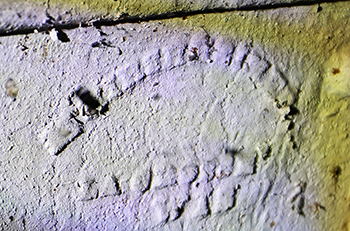
Ash pit door detail from the Morris Hirshheimer foundry
Morris, brother to La Crosse Plow Company’s Albert Hirshheimer, was known to have put his moniker on at least one set of iron columns in the La Crosse downtown at the northwest corner of Third and State streets. The ash bin doors could not have been created until the mid-1860s. However, it could be a set of replacement doors that were installed when the house was added on to or remodeled at some later time.
Dr. C. notes, “I think there is a lot more that could be learned from careful examination of the basement. Careful measurements of rooms, tracking the thickness of walls, the material of the walls, differences in the brick or stone, alterations of the floor, shadows or ghosts left on the floor when something was removed.”
In summary, Dr. C exclaims, “I am convinced that the rear portion of the house, west of the big bay on the north is a much older building and from the evidence that Anita has discovered it seems likely that the photo you copied shows the east side of the original house. It was common for first houses to be built midway on the lot with the belief that a newer, better section would be added on toward the street. You can clearly see the rear, old section, on the Martindale house and the taller new part in front. There are several others in this area like that which have been demolished. And we know a lot of houses that were moved so there was an existing attitude of “reuse” the old in spite of having enough lumber to build a highway to the moon…this house should get more attention as part of the small area with the Martindale, Vincent, Bentley-Wheeler, Withee houses. A small area with outstanding houses from the early 1860s into the 1890s altogether.”

In this photo, more evidence of an older structure is seen in the uncommon way the dormer and side entrance abut the “newer” part of the home. A builder would not have constructed a new structure in this manner.
To come around full circle, the hand-written caption in ink pen was indeed correct in identifying both the builder and the location.
Rev. Sherwin did erect the house or in other words, commissioned the house to be built – but neither he nor his family ever lived there. They left La Crosse just before or shortly after the house was habitable, but maintained owning the property for an additional ten years, enjoying any rental monies for this and other land.
The location is also correct – the northwest corner of Cameron Avenue and 10th Street. Because later owner Fred Ring Jr. wanted to add on in the modern architectural taste of the day, the Queen Anne style, Ring’s carpenter/contractor did his best to “marry” or join the styles of the old house with the new in order to ‘keep up appearances’ in the bourgeois neighborhood.
So, why was this early image taken of an early La Crosse house that served as a rental property for so long? Perhaps it was a business decision to help rent out the building or even sell the property. If Dr. C’s estimate of the age of the trees in the stereoview are correct, the image would date from approximately 1872-1877. W. W. Webb was the owner from 1870-1878 so it was likely he was the one using photography perhaps as a way to sell the house or he just wanted to have a visual keepsake of his home. Looking back in time, we can only speculate the owner’s motivation, but we are glad that this image survived and is a part of the archival collection for present and future generations.
